The minimum tools a blacksmith needs are anvil, hammer and forge.
The forge is perhaps the most variable of the smiths tools.
It can be fueled by a wide range of fuels and come in many configurations.
Its task is simple, to produce a sufficiently high temperature and in sufficient capacity to make metal plastic or even melt it.
In practice a forge is a container to hold fuel while air is blown into the fire.
A good forge helps focus the fire to make a hot spot efficiently and support the work in the fire.
While the source of air (the blast) is a necessity for all fuel burning forges.
Air can be provided by anything from blow pipes and bellows to modern air compressors and electric blowers.
There are so many ways to produce the blast that it is a separate subject.
[see link]
The Steam Era of the 1800's was the peak of the industrial revolution where virtually every machine tool and mechanical device was invented as well as many home appliances and pieces of farm equipment.
The blacksmith shop was revolutionized with hand crank drill presses, shears, punch presses and forges with efficient hand crank or line shaft driven blowers.
This was also the era of the steam hammer and
mechanical power hammer as well as bringing us cast iron forges and forge parts.
Forge improvements included cast "ducks nest" tuyeres, fire pots and complete portable forges ranging from light weight rivet forges and heavy duty industrial forges.
By the end of the 1800's gas and fuel oil forges wer in use as well as improved coal and coke forges.
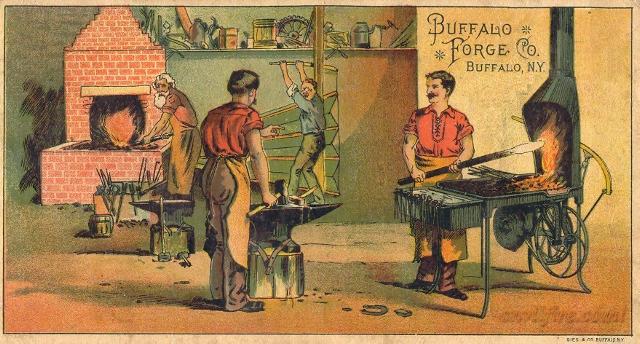
1870's Buffalo Forge advertising card showing old forges and new.
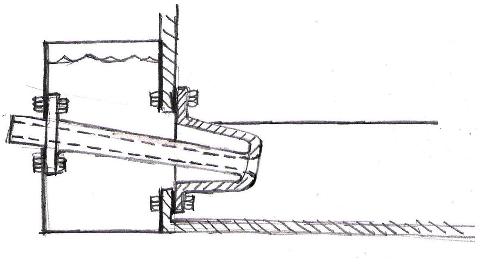
Side Blast Water Cooled Iron Forge
Some of these modern "portable" iron forges use a water cooled tuyere to prevent burnout of the nozzle that sticks out into the fire.
These are preferred by British smiths and have not caught on in the Americas where we use a bottom blast forge (below).
They have been used with bellows and blowers of various types.
The down side of water cooled tuyeres is that they can freeze and break in cold weather if a shop is unheated.
The up side is that they produce hot water in shops that don't even have running water.
But the complexity of both is generally not considered worth while in the vast majority of shops.
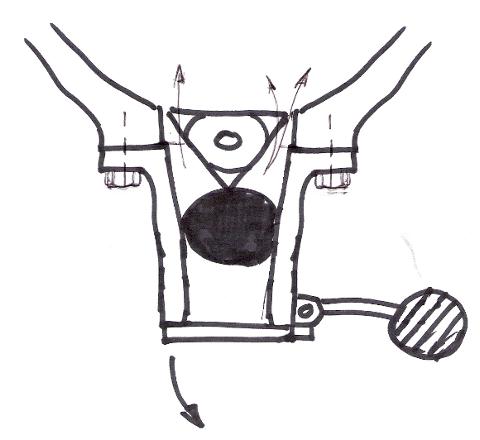
The bottom blast forge
These are currently the preferred coal forge in the Americas.
There are several type of "clinker breaker" but the "ball" type is the most simple and durable.
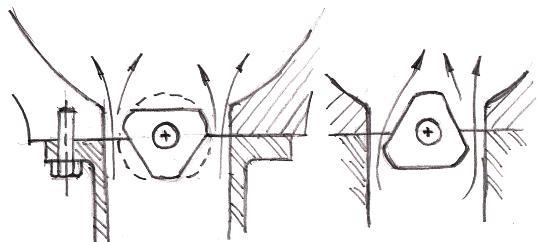
Ball Grate Detail
The "ball" grate is actually triangular in cross section. If used in a round hole it is a sphere with flats but if used in a rectangular hole it is a triangle with flattened corners. These grates allow creating a diffuse or a focused fire as well as dumping ash and clinker.
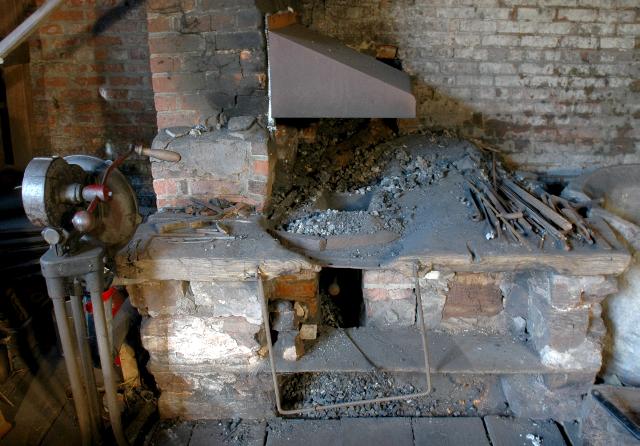
Hybrid Forge at Old Millstone Forge, Millstone, NJ, USA
The forge above was originally a standard bellows blow masonry side blast forge as used throughout the 18th century.
Later it was converted to a hand crank blower and bottom blown cast iron firepot.
Other hybrid forges have been built from the start with
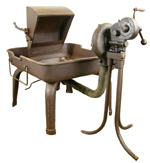
Large Champion
Downdraft Forge |
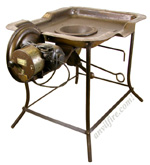
Buffalo Forge with
Electric Blower and OEM Control |
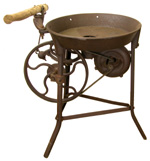
Lever Operated Rivet Forge |
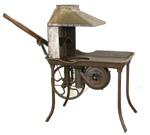
Lever Operated Rectangular Forge with Hood |
Canadian Blower and Forge Coal Forge
Article in Progress



In practice a forge is a container to hold fuel while air is blown into the fire. A good forge helps focus the fire to make a hot spot efficiently and support the work in the fire.
While the source of air (the blast) is a necessity for all fuel burning forges. Air can be provided by anything from blow pipes and bellows to modern air compressors and electric blowers. There are so many ways to produce the blast that it is a separate subject. [see link]
The Steam Era of the 1800's was the peak of the industrial revolution where virtually every machine tool and mechanical device was invented as well as many home appliances and pieces of farm equipment. The blacksmith shop was revolutionized with hand crank drill presses, shears, punch presses and forges with efficient hand crank or line shaft driven blowers. This was also the era of the steam hammer and mechanical power hammer as well as bringing us cast iron forges and forge parts. Forge improvements included cast "ducks nest" tuyeres, fire pots and complete portable forges ranging from light weight rivet forges and heavy duty industrial forges. By the end of the 1800's gas and fuel oil forges wer in use as well as improved coal and coke forges.
1870's Buffalo Forge advertising card showing old forges and new.
Side Blast Water Cooled Iron Forge
The down side of water cooled tuyeres is that they can freeze and break in cold weather if a shop is unheated. The up side is that they produce hot water in shops that don't even have running water. But the complexity of both is generally not considered worth while in the vast majority of shops.
The bottom blast forge
Ball Grate Detail
Hybrid Forge at Old Millstone Forge, Millstone, NJ, USA
Large Champion
Downdraft Forge
Buffalo Forge with
Electric Blower and OEM Control
Lever Operated Rivet Forge
Lever Operated Rectangular Forge with Hood
Canadian Blower and Forge Coal Forge
Article in Progress